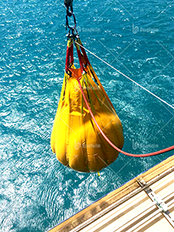Why This Matters Now
Every day, professionals and hobby divers alike face the challenge of recovering objects from underwater—whether it’s a piece of machinery, a sunken boat, or historical artifacts. At Sunhelm, we know lifting heavy loads from depths isn’t just technical—it’s urgent. A small miscalculation can cost hours of work or even pose serious safety risks. With boat engines, pipelines, or debris sinking unexpectedly, the right lift‑bag method ensures recovery is fast, safe, and efficient. From marine construction sites to diving expeditions, understanding underwater lift bags is crucial for success.

Featured Snippet: What Exactly Is an Underwater Lift Bag?
An underwater lift bag is a durable, air‑tight fabric bag attached to a heavy object underwater. When inflated, it displaces water with air, creating enough buoyant force to make the object rise to the surface. Each liter of air adds approximately 1 kg of lift in water—or about 62 lbs per cubic foot.
How Lift Airbags Work — Step by Step
- Choose the right type for the job.
- Open (parachute) lift airbags spill excess air at the bottom during ascent, making them ideal for large dynamic lifts with changing pressure.
- Closed (enclosed or pillow) lift airbags retain their air via overpressure valves—great for surface or calm‑water lifts.
- Rig the lift properly.
Connecting straps or sling points should distribute the load evenly and avoid snags. Specialized airbags for propellers or boulders have tailored attachment designs. - Inflate strategically.
At depth, divers introduce compressed air from a hose or tank. Boyle’s Law means air expands as the bag ascends—and too much unchecked expansion can cause a runaway lift. Use dump valves or vent systems to release excess air. - Manage the ascent.
Keep a controlled rate by venting or adding air. Use hold‑back lines or capsizing/inverter lines to prevent uncontrolled rise or bag inversion. - Secure the object at the surface.
Once surfacing, additional flotation or rigging may be needed to keep the object stable until recovered aboard a vessel.
Featured Snippet: Why Precision Air Volume Matters
Each litre of air in the bag at depth lifts roughly 1 kg of load; but the volume at surface pressure can expand several times due to pressure change—so matching the right amount of air and controlling venting is essential for safe lifting.
Real‑World Example: The Power of Planning
Picture a diver securing a boat’s anchor to a lift bag at 20 m depth. A 100 kg object needs about 100 L of air at that depth—around 15 m³ of surface‑equivalent air—to lift it. As the bag rises, the diver vents air to avoid a sudden surface pop and maintains a slow controlled ascent. That’s how trained teams at Sunhelm get it done reliably and safely.
FAQ
- How do divers calculate the exact air volume needed?
It involves the object’s density, submerged weight, water density, and Boyle’s Law. The calculation gives needed litres at depth; multiplied by ambient pressure (ATA) gives surface‑equivalent volume. - What’s the difference between open and closed lift airbags?
Open airbags vent excess air as they ascend and avoid overpressure; closed airbags retain air with a relief valve, suited for surface or vessel lifts. - What are the main risks of using lift airbags?
Hazards include uncontrolled ascents, air loss from leaks, snags in rigging, improper bag sizing, and diver entanglement. - Can recreational divers use heavy lift airbags safely?
Most heavy‑duty lifts require professional training—very large lift airbags are filled from compressors, not a diver’s tank. Recreational use is limited to small lift or safety‑stop applications.
Why Sunhelm?
At Sunhelm Marine, our lifting airbags are built with robust materials and designed for reliability—from parachute‑style open airbags to enclosed cylinders. With years of experience in heavy‑lifting solutions and ISO‑certified production, we tailor lift bag solutions to your project’s scale and safety requirements.


